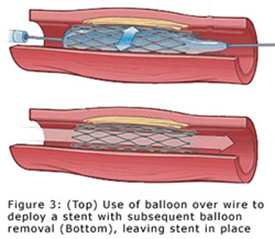There are many different treatment options used to treat peripheral artery disease (PAD). The percutaneous revascularization of diseased arteries can be performed using balloons and stents or by removing the plaque with atherectomy devices. There are 4 types of atherectomy devices: orbital, rotational, laser and directional atherectomy. Tyler Cardiac & Endovascular Center provides comprehensive state-of-the-art technology and equipment for its patients, some of which cannot be found at any other facility in East Texas.
Groundbreaking Procedure at Tyler Cardiac & Endovascular Center
Treatment Options
- Atherectomy
- Drug Coated Balloons
- Intra-vessel Ultrasound Imaging
- OCT Guided Directional Atherectomy
- Balloons/Stents
- CO2 Angiography
- Medication
At Tyler Cardiac & Endovascular Center we offer an alternate to (iodine) contrast dye for our patients that have renal impairment and are at risk for complications from the use of contrast. This option is to use CO2 instead of contrast containing iodine to displace the blood in the artery to help visualize any blockages in the peripheral vascular bed.
Critical Limb Ischemia
Many people suffer with peripheral artery disease (PAD). Left untreated, PAD can be associated with non-healing wounds which may lead to amputation. If you have a history of diabetes, tobacco abuse, heart disease, high cholesterol, or kidney disease you are at risk for PAD. Ischemia is defined as inadequate blood flow to the tissue. When this occurs, the tissue begins to die. By improving blood flow to the tissue, this can be corrected. Evidence shows that in most cases these minimally invasive interventions can help increase the blood flow to these critical wounds. Our goal at TCEC is to improve the quality of life for our patients. By increasing the blood flow to a wound, the wound has a better chance to heal. These vascular interventions aim to minimize the degree of amputation and may prevent amputation altogether.
Atherectomy
When plaque builds up in an artery, blood flow can be blocked and leads to leg pain (claudication) or non-healing wounds. Atherectomy is a procedure that can be performed to remove plaque from the arteries. There are several treatment options that utilize minimally invasive devices. One option is to grind away calcium that narrows the artery. Another option is a small cutting tool that can be advanced to the plaque where it shaves it away. This technique removes the plaque entirely from the body through a small catheter. A third option would be to utilize a laser to dissolve the plaque. Atherectomy is an excellent treatment option that allows our patients to obtain a better quality of life and reduces their lower extremity pain. These treatment options can also be very beneficial in the treatment of non-healing wounds which decreases the need for amputation.
Balloon Angioplasty
 Balloon angioplasty is another type of procedure that can be performed to increase the natural blood flow within an artery. During this procedure, a balloon is advanced to the site of the narrowing and inflated in order to push the plaque towards the wall of the artery. Balloon angioplasty can be performed independently, or in addition to atherectomy and/or stenting.
Balloon angioplasty is another type of procedure that can be performed to increase the natural blood flow within an artery. During this procedure, a balloon is advanced to the site of the narrowing and inflated in order to push the plaque towards the wall of the artery. Balloon angioplasty can be performed independently, or in addition to atherectomy and/or stenting.
Stents
A stent is a very small cylindrical metal tube that can be placed in the artery to help prevent the artery from narrowing again in the future. It can be used alone, or in conjunction with atherectomy or balloon angioplasty. Stents are particularly successful in the larger arteries found in the legs.



